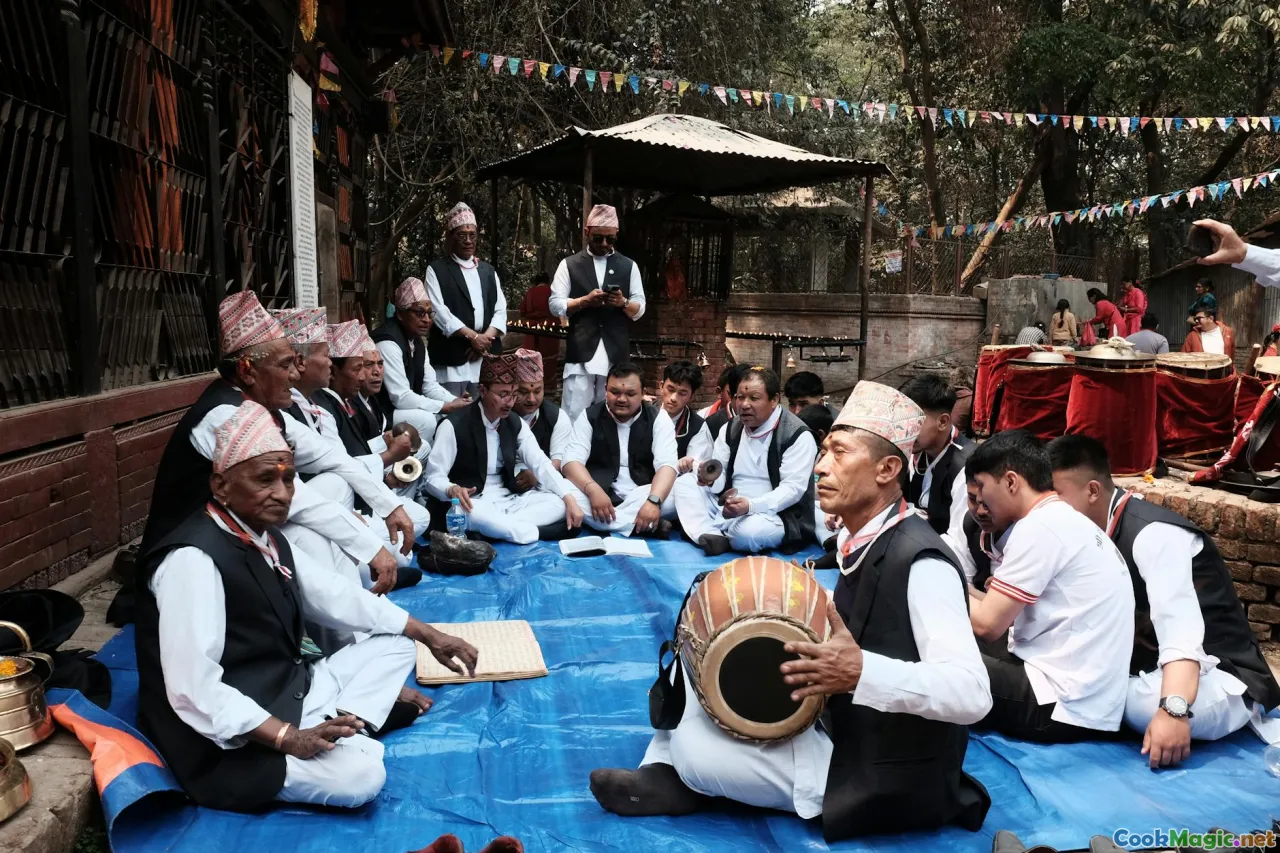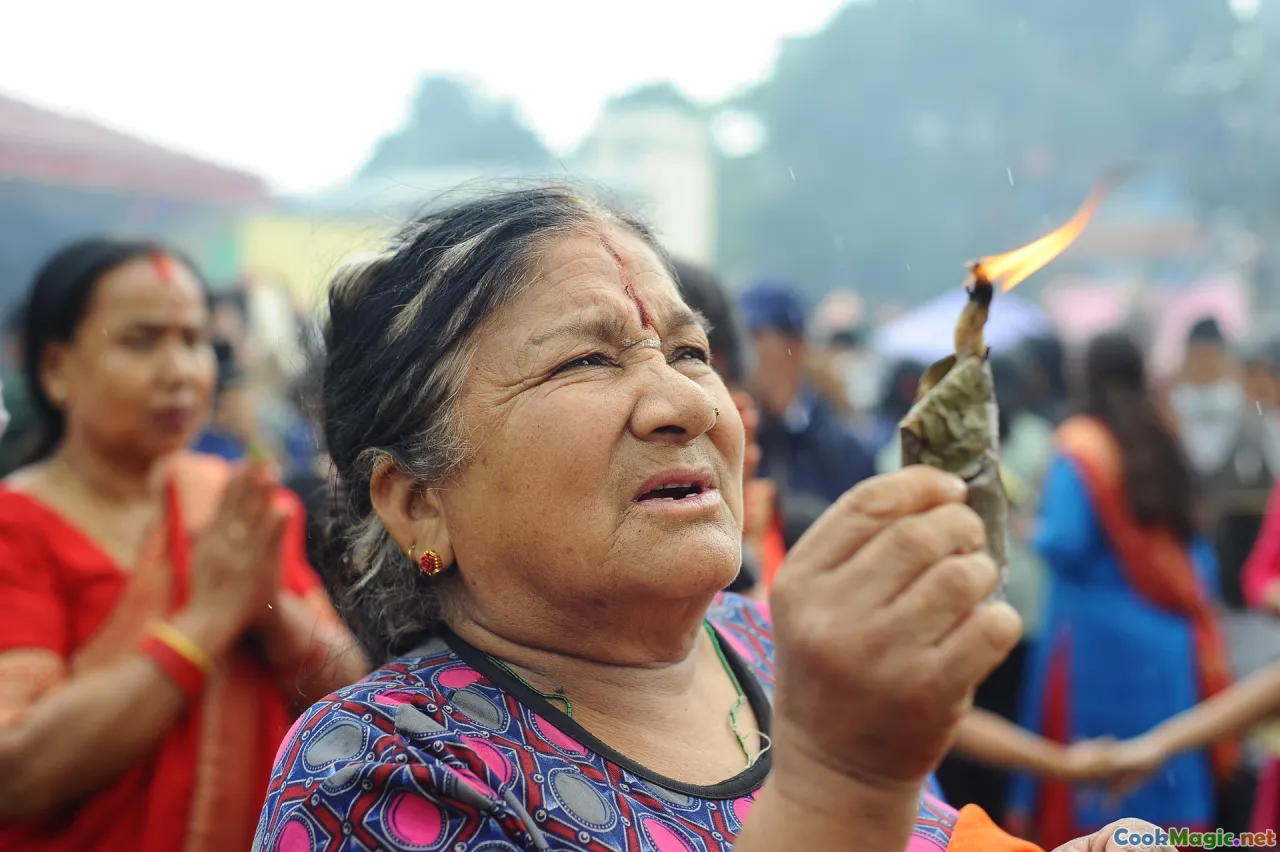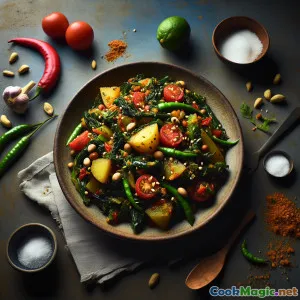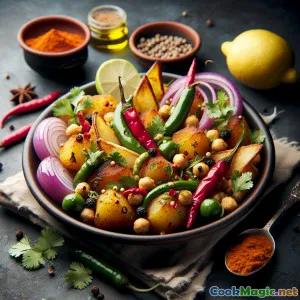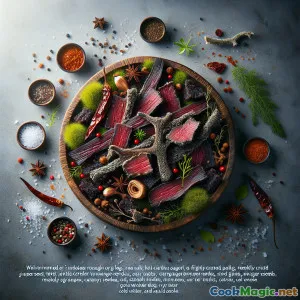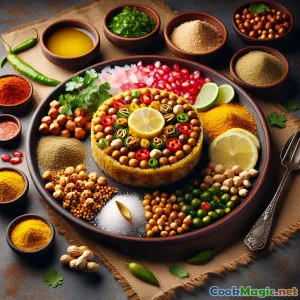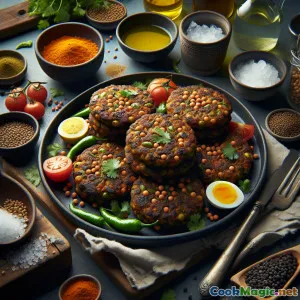
Bara croccante: Frittelle di lenticchie Newari al ghee speziato
(Crisp Bara: Newari Lentil Cakes with Spiced Ghee)
(0 Recensioni)0
157
ottobre 04, 2025
Segnala un problema
Ingredienti
-
300 grams Urad dal indiano (lenticchia nera), spezzato o intero
(Traditional maas ko dal; rinse well)
-
1000 ml Acqua per ammollo
(Enough to cover lentils by 5 cm; discard after soaking)
-
200 ml acqua ghiacciata (per la macinazione)
(Add as needed for a thick, pourable batter)
-
1.5 tsp Semi di cumino
(Lightly crushed for best aroma)
-
2 tsp Zenzero fresco, grattugiato finemente
(Adds warmth and freshness)
-
2 cloves Spicchi d'aglio, tritati
(Classic depth and savoriness)
-
2 small Peperoncini verdi, finemente tritati
(Regolare in base alla preferenza di calore)
-
0.25 tsp Afasfetida (Hing)
(A little goes a long way; boosts umami)
-
1.25 tsp sale marino fine
(Divide between batter and finishing)
-
1 pinch Bicarbonato di sodio
(For extra lift; traditional recipes may omit)
-
0.25 tsp Polvere di Curcuma
(Optional color and earthiness)
-
0.5 tsp Semi di Fieno Greco
(Tempered for aromatic oil)
-
2 tbsp olio di senape (o olio neutro)
(For tempering and griddle frying)
-
1 tbsp Ghee
(Finish with a fragrant drizzle)
-
2 tbsp Coriandolo fresco (tritato)
(Fold into batter for freshness)
-
2 tbsp Cipollotti affettati sottilmente
(Extra crunch and aroma)
-
2 pieces Uova (per il topping Anda Bara)
(Crack onto cakes after flipping)
-
2 medium Pomodori maturi
(For quick tomato-sesame achar)
-
2 tbsp semi di sesamo tostati
(Ground into achar)
-
1 tbsp Succo di limone
(Achar brightness)
-
0.25 tsp Sale (per achar)
(Regolare a piacere)
-
0.25 tsp Fiocchi di peperoncino (per achar)
(Optional heat in achar)
-
0.25 tsp Pepe nero macinato
(To finish the cakes)
(Traditional maas ko dal; rinse well)
(Enough to cover lentils by 5 cm; discard after soaking)
(Add as needed for a thick, pourable batter)
(Lightly crushed for best aroma)
(Adds warmth and freshness)
(Classic depth and savoriness)
(Regolare in base alla preferenza di calore)
(A little goes a long way; boosts umami)
(Divide between batter and finishing)
(For extra lift; traditional recipes may omit)
(Optional color and earthiness)
(Tempered for aromatic oil)
(For tempering and griddle frying)
(Finish with a fragrant drizzle)
(Fold into batter for freshness)
(Extra crunch and aroma)
(Crack onto cakes after flipping)
(For quick tomato-sesame achar)
(Ground into achar)
(Achar brightness)
(Regolare a piacere)
(Optional heat in achar)
(To finish the cakes)
Nutrizione
- Porzioni: 4
- Dimensione Porzione: 2 cakes (180g)
- Calories: 410 kcal
- Carbohydrates: 0 g
- Protein: 18 g
- Fat: 12 g
- Fiber: 15 g
- Sugar: 3 g
- Sodium: 540 mg
- Cholesterol: 15 mg
- Calcium: 120 mg
- Iron: 5.2 mg
Istruzioni
-
1 - Rinse and soak lentils:
Rinse urad dal under cold water until it runs clear. Cover with plenty of water and soak 8 hours or overnight until fully hydrated and slightly swollen.
-
2 - Drain and prep aromatics:
Drain and rinse soaked dal. Prepare ginger, garlic, chilies, and lightly crush cumin seeds. Have ice-cold water ready for grinding.
-
3 - Grind to thick batter:
Grind dal with 150–200 ml ice water in batches to a smooth, thick, spoonable batter. Aim for soft peaks that mound and slowly level. Avoid overheating the batter.
-
4 - Season and aerate:
Fold in cumin, ginger, garlic, green chilies, asafoetida, salt, and turmeric (if using). Whisk vigorously 1–2 minutes to trap air. Add a pinch of baking soda if desired.
-
5 - Temper fenugreek oil:
Heat mustard oil until shimmering. Add fenugreek seeds; let them deepen in color and perfume the oil (15–20 seconds). Strain the aromatic oil into the batter and fold. Discard seeds if very dark.
-
6 - Preheat griddle:
Heat a cast-iron skillet or tawa over medium heat. Lightly oil the surface. The pan is ready when a drop of batter sizzles gently without smoking.
-
7 - Shape and cook first side:
Spoon 1/4 cup batter onto the griddle; gently spread into a 8–9 cm round about 8–10 mm thick. Cook 3–4 minutes until edges set and bottom turns golden.
-
8 - Flip and finish (optional egg):
Flip carefully. For anda bara, crack an egg over the cake, letting it set on top; cover 1–2 minutes. Otherwise, cook 2–3 minutes until cooked through. Drizzle ghee to finish.
-
9 - Repeat and keep warm:
Repeat with remaining batter, lightly oiling as needed. Keep finished cakes warm in a low oven (90°C/195°F). Sprinkle with pepper and a pinch of salt.
-
10 - Optional quick tomato-sesame achar:
Char tomatoes over flame or under broiler until blistered. Peel, mash with roasted sesame, lemon juice, salt, and chili flakes into a coarse relish. Adjust seasoning.
-
11 - Serve:
Top with cilantro and scallions. Serve hot with tomato-sesame achar. Enjoy as a snack, street-food style, or part of a festive Newari spread.
Rinse urad dal under cold water until it runs clear. Cover with plenty of water and soak 8 hours or overnight until fully hydrated and slightly swollen.
Drain and rinse soaked dal. Prepare ginger, garlic, chilies, and lightly crush cumin seeds. Have ice-cold water ready for grinding.
Grind dal with 150–200 ml ice water in batches to a smooth, thick, spoonable batter. Aim for soft peaks that mound and slowly level. Avoid overheating the batter.
Fold in cumin, ginger, garlic, green chilies, asafoetida, salt, and turmeric (if using). Whisk vigorously 1–2 minutes to trap air. Add a pinch of baking soda if desired.
Heat mustard oil until shimmering. Add fenugreek seeds; let them deepen in color and perfume the oil (15–20 seconds). Strain the aromatic oil into the batter and fold. Discard seeds if very dark.
Heat a cast-iron skillet or tawa over medium heat. Lightly oil the surface. The pan is ready when a drop of batter sizzles gently without smoking.
Spoon 1/4 cup batter onto the griddle; gently spread into a 8–9 cm round about 8–10 mm thick. Cook 3–4 minutes until edges set and bottom turns golden.
Flip carefully. For anda bara, crack an egg over the cake, letting it set on top; cover 1–2 minutes. Otherwise, cook 2–3 minutes until cooked through. Drizzle ghee to finish.
Repeat with remaining batter, lightly oiling as needed. Keep finished cakes warm in a low oven (90°C/195°F). Sprinkle with pepper and a pinch of salt.
Char tomatoes over flame or under broiler until blistered. Peel, mash with roasted sesame, lemon juice, salt, and chili flakes into a coarse relish. Adjust seasoning.
Top with cilantro and scallions. Serve hot with tomato-sesame achar. Enjoy as a snack, street-food style, or part of a festive Newari spread.
Ulteriori informazioni su: Bara croccante: Frittelle di lenticchie Newari al ghee speziato
About This Dish
Bara (also called wo) are iconic Newari lentil cakes from the Kathmandu Valley of Nepal. Think of them as savory, protein-rich pancakes: crisp-edged, lightly chewy, and deeply aromatic with cumin, ginger, and a whisper of asafoetida. They are humble in ingredients yet refined in technique—soaked black gram (urad dal) is ground to a thick, airy batter, then cooked on a griddle and finished with a fragrant hit of ghee. In Newari communities, bara can be enjoyed plain, studded with minced meat, or crowned with an egg (anda bara), making them adaptable for different preferences and occasions.
Flavor and Texture
The soul of great bara lies in the batter. Properly soaked and finely ground urad yields a creamy, elastic base that puffs gently on a hot tawa. Cumin contributes nutty warmth, ginger brings brightness, and asafoetida amplifies savory depth—a touch that nods to traditional Newari kitchens. Mustard oil provides a faintly pungent backbone, while a finishing drizzle of ghee rounds everything with buttery perfume. The result: a golden, crisp surface and a tender interior that is satisfying without heaviness.
A Brief History and Cultural Significance
Bara are closely intertwined with Newar culture—often served during jatras (festivals), family ceremonies, and as a beloved street snack. They reflect a resourceful, grain-and-legume-forward culinary tradition that predates modern convenience but still feels timely today. In communal settings, one person tends the batter while another works the griddle, sending out hot cakes in steady rhythm. The anda variation, cracked directly onto the cake, symbolizes abundance and hospitality when feeding guests.
Tips for Success
- Batter texture: Aim for a thick, spoonable batter that mounds slightly and levels slowly. Too thin and the cakes spread excessively; too thick and they remain dense.
- Keep it cool: Grind with ice-cold water. Heat de-stabilizes the proteins and reduces loft.
- Aeration matters: Whisk the batter just before cooking to trap air. A tiny pinch of baking soda is optional insurance for lift, but traditionalists often rely on technique alone.
- Tempered aroma: A quick fenugreek temper makes the oil fragrant without bitterness. Strain if the seeds over-brown.
- Heat control: Medium heat ensures even browning and a tender interior. High heat scorches before the center cooks through.
- Thickness: About 8–10 mm is the sweet spot—sturdy, but not stodgy.
Variations
- Anda Bara: After the first flip, crack an egg on top; cover briefly so it sets into the cake.
- Meat Bara: Spread a spoonful of seasoned minced buffalo, chicken, or lamb onto the first side before flipping.
- Herb Lift: Fold in chopped cilantro and scallion for fresh green pops.
- Spice Play: Add crushed black pepper, a pinch of turmeric, or toasted sesame to the batter.
Serving Suggestions
Bara shine with bright, nutty condiments. A quick tomato-sesame achar brings smoky acidity and a creamy richness from ground sesame. You can also pair with cucumber raita, radish pickle, or a tart lemon wedge. For a heartier plate, serve bara alongside chhoila (spiced grilled meat), a handful of fresh greens, and a cup of masala tea.
Make-Ahead and Storage
- Soak ahead: Lentils can soak in the fridge up to 24 hours.
- Batter rest: Refrigerate the batter up to 24 hours; re-whisk vigorously before cooking. If it thickens, loosen with a spoonful of cold water.
- Reheating: Re-crisp on a medium-hot skillet with a brush of oil or in a 180°C (350°F) oven for 6–8 minutes. Microwaving softens the crust, so avoid if possible.
Ingredient Notes and Substitutions
- Urad dal: Split or whole both work; whole yields a slightly darker, nuttier cake. If urad is unavailable, a 50/50 mix of split mung and split black gram can approximate the texture, though flavor will differ.
- Oil: Mustard oil is traditional. If unavailable, use peanut or sunflower, finishing with ghee for aroma.
- Asafoetida: A pinch is potent. If you skip it, add a little extra garlic for savory depth.
- Heat level: Green chilies can be swapped for serrano or jalapeño; deseed for milder heat.
Troubleshooting
- Dense cakes: Batter likely too thick or under-aerated. Whisk longer and loosen with a tablespoon of cold water.
- Greasy surface: Pan too cool or over-oiled. Preheat properly and wipe excess oil between batches.
- Raw center: Reduce heat and cook longer, or make slightly thinner cakes.
Why You’ll Love It
Bara embody the elegance of minimalist cooking: a short list of pantry staples transformed by attention to texture, heat, and aroma. They’re naturally gluten-free, high in protein and fiber, and endlessly adaptable—from street-food snack to celebratory centerpiece. Whether you keep them pure or crown them with a runny egg, these Newari lentil cakes deliver comfort, culture, and crisp-edged joy in every bite.

